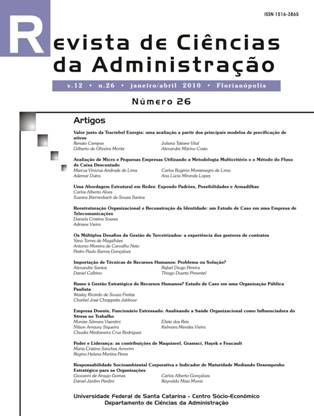Sick company, stressed employee: analyzing the organizational health like influencing the work-related stress
DOI:
https://doi.org/10.5007/2175-8077.2010v12n26p189Abstract
This study investigated the perceived Organizational Health influence on workrelated stress at the restaurants employees in the Santa Maria-RS city. To that end, it was used a survey from employee of the three public and four private restaurants. There has been a factor analysis showed those five factors for work-related stress and four factors of organizational health. Through an examination of correlation showed the multidimensionality of these constructs. Given these results, to check the influence of the perception of organizational health on occupational stress, there was a regression analysis and found to be valid five models that serve the conditions necessary. However, these models have low power of explanation, indicating that the factors of occupational stress are not sufficient to explain the organizational health, should to investigate other aspects of the work environment that interfere in the perception of work-related stressDownloads
Published
How to Cite
Issue
Section
License
The author must ensure:
- that there is complete consensus among all co-authors to approve the final version of the paper and its submission for publication.
- that their work is original, and if the work and/or words of others have been used, these have been duly acknowledged.
Plagiarism in all its forms constitutes unethical publishing behavior and is unacceptable. RCA reserves the right to use software or any other methods of plagiarism detection.
All submissions received for evaluation in the RCA journal are screened for plagiarism and self-plagiarism. Plagiarism identified in manuscripts during the evaluation process will result in the submission being archived. In the event of plagiarism being identified in a manuscript published in the journal, the Editor-in-Chief will conduct a preliminary investigation and, if necessary, retract it.
Authors grant RCA exclusive rights of first publication, with the work simultaneously licensed under the Creative Commons (CC BY) 4.0 International License.

Authors are authorized to enter into separate, additional contractual arrangements for the non-exclusive distribution of the version of the work published in this journal (e.g., publishing in an institutional repository, on a personal website, publishing a translation, or as a chapter in a book), with an acknowledgement of its authorship and initial publication in this journal.
This license grants any user the right to:
Share – copy, download, print, or redistribute the material in any medium or format.
Adapt – remix, transform, and build upon the material for any purpose, even commercially.
According to the following terms:
Attribution – You must give appropriate credit (cite and reference), provide a link to the license, and indicate if changes were made. You may do so in any reasonable manner, but not in any way that suggests the licensor endorses you or your use.
No additional restrictions – You may not apply legal terms or technological measures that legally restrict others from doing anything the license permits.


